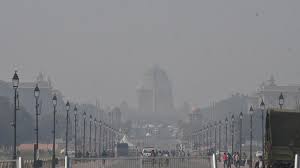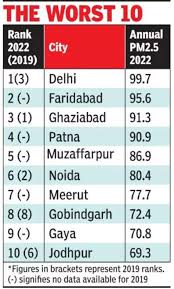Delhi earned the tag of world’s most polluted city
 NEW DELHI : Delhi earned the tag of the world’s most polluted city on Friday after firecrackers were burst on the occasion of Diwali on Thursday despite a blanket ban in the national capital. At 6 am on Friday, the Air Quality Index (AQI) was recorded at 359, which falls in ‘very poor’ category, according to CPCB. The capital has been breathing hazardous air quality for the past few weeks, prompting authorities to impose stage two of the GRAP or the Graded Response Action Plan last week.
NEW DELHI : Delhi earned the tag of the world’s most polluted city on Friday after firecrackers were burst on the occasion of Diwali on Thursday despite a blanket ban in the national capital. At 6 am on Friday, the Air Quality Index (AQI) was recorded at 359, which falls in ‘very poor’ category, according to CPCB. The capital has been breathing hazardous air quality for the past few weeks, prompting authorities to impose stage two of the GRAP or the Graded Response Action Plan last week.
Several areas, including Lajpat Nagar, Kalkaji, Chhatarpur, Jaunapur, East of Kailash, Saket, Rohini, Dwarka, Punjabi Bagh, Vikaspuri, Dilshad Garden, Burari and many other neighbourhoods of east and west Delhi saw firecrackers being burst.
The air quality in Delhi worsened this morning as people defied a ban on firecrackers during Diwali celebrations on Thursday. The relentless bursting of firecrackers caused severe noise pollution and blanketed the national capital in dense smoke with residents flouting the restrictions till late at night.
At 6 am, areas including Burari Crossing (394), Jahangirpuri (387), RK Puram (395), Rohini (385), Ashok Vihar (384), Dwarka Sector 8 (375), IGI Airport (375), Mandir Marg (369), Punjabi Bagh (391), Anand Vihar (395), Siri Fort (373) and Sonia Vihar (392) saw the air quality at the higher end of the ‘very poor’ category and were at risk of reaching the ‘severe’ category, CPCB data showed. NCR areas Noida, Ghaziabad and Gurugram recorded AQI levels at 293, 316 and 348, respectively, with the former in the ‘poor’ category while the latter two in the ‘very poor’ category.
The pollution levels at many of the pollution measuring stations of Delhi NCR touched the peak
Around midnight. While the PM2.5 and PM10 levels dipped significantly after 1 am, they still remain critical. The deterioration started after 5 pm on Thursday, around the time the bursting of firecrackers was reported in the national capital. Due to the defiance of the cracker ban, PM2.5 levels in several areas soared as high as 900 micrograms per cubic meter – over 15 times the acceptable limit.
the ban on firecrackers across the capital.
A senior Delhi Police officer said all deputy commissioners of police (DCPs) were asked to form dedicated teams to ensure that firecrackers do not burst in their respective districts. Last year, the “festival of lights” was celebrated on November 12 and Delhi recorded its best air quality on Diwali day in eight years, with the average AQI at 218.
At 8 pm, monitoring stations like RK Puram and Jahangirpuri recorded these alarming levels. By 10 pm, other areas, including Nehru Nagar, Patparganj, Ashok Vihar, and Okhla, showed PM2.5 levels between 850–900 micrograms per cubic meter, far exceeding the safety threshold of 60 micrograms per cubic meter. An AQI between zero and 50 is considered ‘good’, 51 and 100 ‘satisfactory’, 101 and 200 ‘moderate’, 201 and 300 ‘poor’, 301 and 400 ‘very poor’, 401 and 450 ‘severe’ and above 450 ‘severe plus’. On October 14, the Delhi government imposed a ban on the production, storage, sale, and use of firecrackers across the city, effective until January 1, 2025.
On Diwali morning, Delhiites woke up to a thick layer of smog blanketing the national capital as the air quality was in the ‘very poor’ category with a recorded AQI of 328 at 4 pm. This was the worst air quality recorded in Diwali in the past three years.
Several pollution measuring stations reported PM2.5 levels up to 900 micrograms per cubic meter.
According to the real-time data provided by the System of Air Quality and Weather Forecasting and Research (SAFAR), Delhi’s air quality index (AQI) soared to 359 at 6:30 am, which falls under the “very poor” category. The AQI on the morning of Diwali was at 328. Levels of fine particulate matter — dangerous microparticles known as PM2.5 pollutants that enter the bloodstream through the lungs — increased to more than 23 times the World Health Organization recommended daily maximum.
Monitoring firm IQAir said the pollutant levels topped 345 micrograms per cubic metre and rated Delhi as the worst in the world. The AQI level in most of the 40 monitoring stations in the city remained in the “very poor” category with Anand Vihar and RK Puram reporting the worst air quality index of 395. As per the CPCB, the AQI of the area is 317, in the ‘very poor’ category.
Burari Crossing (394), Sonia Vihar (392), Punjabi Bagh (391), North Campus (390), Bawana (388), Jahangirpuri (387), Rohini (385), Ashok Vihar (384), and Nehru Nagar (381) were some other places with the “very poor” air quality. The Indian Institute of Tropical Meteorology (IITM), Pune, has said that the air quality in the national capital is likely to be in the “very poor” category on Friday.
On Diwali eve, Delhi Environment Minister Gopal Rai announced that 377 teams were formed to enforce
Pollution killed over 2.3 million Indians in 2019. Nearly 1.6 million deaths were just due to air pollution. The latest Lancet report on pollution and health unveiled such data. The report also blamed pollution for nine million premature deaths globally.
(Bureau Report with Media Inputs).

